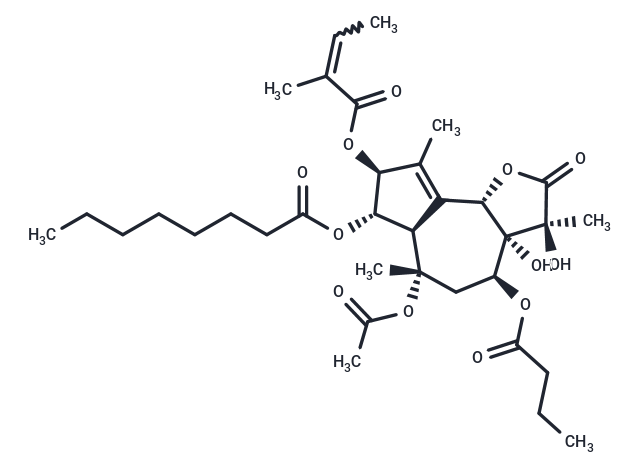Shopping Cart
- Remove All
 Your shopping cart is currently empty
Your shopping cart is currently empty

Thapsigargin is a natural product, an inhibitor of sarcoplasmic/endoplasmic reticulum Ca2+ ATPase (SERCA) and an endoplasmic reticulum stress inducer. Thapsigargin increases cytoplasmic calcium concentration by blocking the ability of cells to pump calcium into the sarcoplasmic and endoplasmic reticulum.

| Pack Size | Price | Availability | Quantity |
|---|---|---|---|
| 1 mg | $82 | In Stock | |
| 1 mL x 10 mM (in DMSO) | $570 | In Stock |
| Description | Thapsigargin is a natural product, an inhibitor of sarcoplasmic/endoplasmic reticulum Ca2+ ATPase (SERCA) and an endoplasmic reticulum stress inducer. Thapsigargin increases cytoplasmic calcium concentration by blocking the ability of cells to pump calcium into the sarcoplasmic and endoplasmic reticulum. |
| In vitro | METHODS: Human rheumatoid arthritis synoviocytes MH7A were treated with Thapsigargin (0.001-1 μM) for 2-4 days, and cell proliferation was detected using the SRB. RESULTS: Thapsigargin inhibited the proliferation of MH7A cells in a time- and dose-dependent manner. [1] METHODS: Human hepatocellular carcinoma cells HepG2 were treated with Thapsigargin (25-100 nM) for 24 h. Endoplasmic reticulum stress/UPR gene expression was detected by RT-qPCR. RESULTS: Thapsigargin treatment consistently induced ER stress gene expression only at elevated concentrations of 50 and 100 nM. [2] |
| In vivo | METHODS: To assay in vivo ER stress-inducing activity, Thapsigargin (0.25-1 μg/g in 150 mM dextrose containing 1% DMSO) was administered as a single intraperitoneal injection to Balb/c mice in order. RESULTS: Thapsigargin treatment resulted in significant expression of the ER stress markers ATF6 and eIF2α in adipose tissue. thapsigargin treatment failed to induce the expression of most of the ER stress and UPR proteins in the liver. [2] METHODS: To investigate the antiviral function in vivo, Thapsigargin (30 ng/mouse) was administered by gavage to PR8 virus-infected BALB/c mice once daily for seven days. RESULTS: Oral administration of Thapsigargin to mice significantly reduced severity and viral shedding and improved survival during infection with the deadly influenza virus. [3] |
| Cell Research | Cell Line: MH7A human rheumatoid arthritis synovial cells. Concentration: 0.001, 0.1, and 1?μM. Incubation Time: For 2 and 4 days [2] |
| Animal Research | Animal Model: Male Balb/c mice (20-25g). Dosage: 0.25ug/g, 0.5ug/g and 1ug/g. Administration: Injection; 24 hours [4] |
| Molecular Weight | 650.75 |
| Formula | C34H50O12 |
| Cas No. | 67526-95-8 |
| Smiles | CCCCCCCC(=O)O[C@@H]1[C@@H](OC(=O)C(C)=CC)C(C)=C2[C@@H]3OC(=O)[C@@](C)(O)[C@@]3(O)[C@H](C[C@](C)(OC(C)=O)[C@@H]12)OC(=O)CCC |
| Relative Density. | 1.1521 g/cm3 (Estimated) |
| Storage | store at low temperature,keep away from moisture | Powder: -20°C for 3 years | In solvent: -80°C for 1 year | Shipping with blue ice. | ||||||||||||||||||||||||||||||
| Solubility Information | DMSO: 45 mg/mL (69.15 mM), Sonication is recommended. | ||||||||||||||||||||||||||||||
Solution Preparation Table | |||||||||||||||||||||||||||||||
DMSO
| |||||||||||||||||||||||||||||||

Copyright © 2015-2025 TargetMol Chemicals Inc. All Rights Reserved.